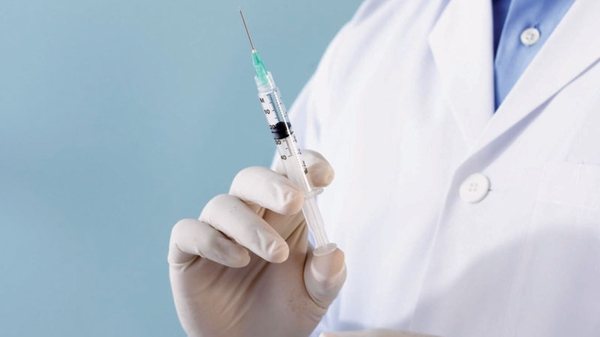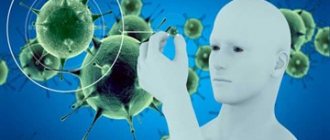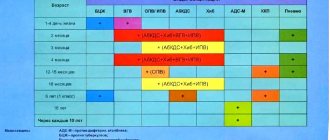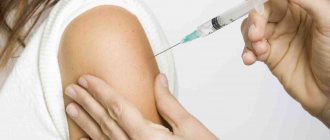Measles is a viral disease characterized by a number of unpleasant consequences and complications and enters the body through the respiratory tract, mucous membranes of the nose and mouth. Measles was described as a separate disease in the 17th century, but there is still no etiotropic treatment aimed at eliminating its cause. The doctor prescribes individual treatment for each patient, which can only alleviate the symptoms. But one of the features of the course of this disease is a very high degree of transmission from a patient to a healthy person, almost 100%. At the same time, at the initial stage, measles can occur with mild symptoms, and the incubation period in an adult lasts up to a month. But most often children of preschool and primary school age get measles.
The only way to prevent health damage today is measles vaccination. The first vaccinations were tested 300 years ago, but researchers are still working on new vaccines, creating an increasingly effective and long-lasting drug. Nina Yandraykina, a pediatrician at the MEDSI children's clinic on Pirogovskaya, talks about the characteristics of measles in children and which measles vaccination for children would be optimal in modern conditions .
Federal News Agency / Photos courtesy of Nina Yandraykina
Measles is a truly dangerous disease, and above all because in most cases it occurs with pronounced symptoms, which in themselves are painful for the child: if it is a temperature, then it is very high, up to 39–40 degrees, if it is a cough, then it is sharp, irritable, if conjunctivitis, then with swelling of the eyes and photophobia. General symptoms are also clearly expressed - severe weakness, loss of appetite, headache, and sometimes vomiting, delirium, and convulsions can even occur.
“Measles is also dangerous because, even without complications, it sharply reduces immunity. Researchers have proven that the measles virus leads to T-immunodeficiency, that is, to a deficiency of cells that create immunity. This state of “anergy” lasts about a month after the illness itself and can cause the development of other diseases,” says Nina Yandraykina.
Complications from measles are also not simple - they are pneumonia, otitis media, laryngitis, stomatitis, and severe encephalitis. Laryngitis can occur with measles croup. The impressive list of complications continues with hepatitis, pancreatitis, thrombocytopenic purpura (ITP, primary immune thrombocytopenia, Werlhof's disease - an autoimmune blood disease), hemorrhagic syndrome - skin hemorrhage, bleeding of the mucous membranes, pericarditis, myocarditis (damage to the heart muscle) and keratitis, which leads to blindness . Subacute sclerosing panencephalitis is considered an extremely severe complication. The prefix “pan” means “solid”, that is, it is a continuous inflammation of brain tissue - a disease leading to loss of vital functions and early death. And it occurs in children with measles under two years of age. As studies have shown, it was vaccination that contributed to a sharp decrease in the incidence of panencephalitis.
It is also important to know that there is no single antiviral drug against measles. Treatment of measles is nonspecific, it is aimed at eliminating individual symptoms.
The danger of measles also lies in its high contagiousness and high susceptibility. The disease is transmitted by airborne droplets; one person can infect 18 others in contact with him. The measles susceptibility index is 0.96. People who have not previously had measles and have had direct, even short-term contact with a sick person, almost all become ill, regardless of age.

pixabay.com/Pexels
How does measles occur in children and how do signs of the disease appear?
There are different degrees of the disease - mild, moderate and severe. However, in children, measles most often develops in moderate and severe forms, and is especially severe in children under two years of age. The mild form at the onset of the disease is quite dangerous, when the child has a slight fever, a slight cough, and can still attend kindergarten or school. If the disease is not tracked in time, such a child can infect all other unvaccinated children in the kindergarten or in the entire school (due to its high contagiousness).
The main symptoms of measles are fever, weakness, catarrh of the upper respiratory tract, inflammation of the eyes, and rash. The disease occurs cyclically. The first stage is catarrhal, when the main symptoms appear - cough, runny nose, fever, general weakness, conjunctivitis with photophobia and a “semolina”-type rash on the oral mucosa (the so-called Belsky-Filatov-Koplik spots), characteristic only of measles. Before the second stage begins, the temperature usually drops.
“After 3-4 days, the next stage begins - the period of rash. This is the peak of the disease, in which all the symptoms increase sharply, the temperature rises again and can reach 40 degrees or more, the cough intensifies, the lips and eyelids swell, the eyes water or fester, it hurts to look at the light, says Nina Yandraykina. “And a rash appears, starting from the area behind the ears and from the cheeks, then going down to the neck and chest, and the next day - to the entire torso, and on the third day also to the limbs. This stage lasts on average 3–4 days. Then comes the third stage - the period of pigmentation, when the rash gradually turns pale, disappears within 7-10 days, turning into light brown spots and accompanied by pityriasis-like peeling on the body, the temperature normalizes, and appetite appears.”
But, despite the improvement in the condition, the pigmentation phase is characterized by the presence of “anergy”, that is, a decrease in immunity. Therefore, those recovering from measles should be especially protected from contact with other infections and from physical and emotional stress.

pskovgorod.ru / City of Pskov
School of Immunoprophylaxis
Measles immunoprophylaxis
Measles is an infectious disease of viral origin that occurs with high fever, intoxication, inflammation of the mucous membranes of the oral cavity and upper respiratory tract, and a maculopapular rash.
Upon contact with a sick person, the disease develops in almost every non-immune person. The source of infection is a sick person. The virus is transmitted from person to person by talking, sneezing, or coughing. The patient is contagious for 4 days before the rash appears and for 4 days after the rash appears. Those who have been vaccinated and children under 3 months born from mothers who have measles immunity are protected from infection. Over time, innate immunity decreases, and by 6-9 months, children become susceptible to infection. If the mother did not have measles immunity, then the child will be sensitive to measles infection from the first day of life. In unvaccinated people, the disease is often accompanied by complications such as thrombocytopenia, measles encephalitis, subacute sclerosing panencephalitis and can be fatal. There is no specific antiviral treatment for measles.
The most effective method of prevention is immunization. In accordance with the national vaccination calendar of the Russian Federation, children are vaccinated at the age of 12 months, and revaccination at 6 years. To develop immunity, two doses of measles vaccine are recommended. Also subject to immunization are adults aged 35 years, and adults at risk aged 36-55 years who are not vaccinated, vaccinated once and do not have information about vaccinations. Risk groups include: employees of medical and educational organizations, trade organizations, transport, public utilities and social spheres; persons working on a rotational basis and employees of state control bodies at checkpoints across the state border of the Russian Federation.
Immunization against measles for citizens of the Russian Federation is carried out free of charge in all medical organizations licensed for this type of activity. In addition, vaccination can be carried out on a paid basis in non-governmental medical organizations that have a license for this type of activity. In our country, measles, mumps-measles and combined (against rubella, measles, mumps) vaccines are used. The protective effect of the vaccine lasts for many years.
If you are still not sure of your protection against measles, you can donate blood to test your immunity: the level of class G immunoglobulins will determine how protected your body is from this infection.
This type of research is carried out in the virology laboratory of the Federal Budgetary Institution of Health "Center for Hygiene and Epidemiology in the Lipetsk Region" (address: Lipetsk, Gagarin St., 60a, contact phone - 308-706).
By protecting yourself, you are protecting your loved ones from measles. Only through vaccination can we defeat measles!
How long does the effect of the measles vaccine last?
“It is believed that the duration of immunity after vaccination is comparable to that during a natural infection, which means lifelong,” says Nina Yandraykina. “But such conclusions require further observations, since the mass use of measles vaccine began only in 1965–1968. There are other data. According to the researchers, depending on the strain of the virus used in the vaccine, the effect lasts on average from 12 to 18 years after the second vaccination. However, some authors provide data that even after 26–33 years, the effect of vaccination continues to operate, and a person has antibodies in protective concentrations.”
Are there possible side effects of the measles vaccine for a child?
Reaction to a vaccine: can it bring unpleasant consequences? This is a question every loving parent asks. Nina Yandraykina agrees that the measles vaccine for children, like others, can have side effects:
“Most often, these are acceptable adverse reactions, when some children develop rashes, cough, runny nose or fever between the fifth and 20th day. But all these symptoms do not last long (2-4 days) and disappear on their own.”
The most unpleasant consequences of measles vaccination for children are high fever (especially dangerous for children prone to febrile convulsions) and allergic reactions to vaccine components, in particular to chicken or quail egg white. These unpleasant reactions can be avoided by observing contraindications to vaccination and taking antipyretic or antiallergic medications.
Who needs to be vaccinated against measles and why?
This year, as the chief sanitary doctor of Russia Gennady Onishchenko has already reported, the incidence of measles in Russia has increased by 22.4 times compared to the same period last year. Cases of measles are registered in 50 constituent entities of the Russian Federation. But measles, epidemiologists say, is “imported” in our country - people who have been in an area where measles is endemic bring it to St. Petersburg and, unwittingly, infect others. Last year and the year before, measles was brought to St. Petersburg mainly from abroad. During this time, only 8 cases of measles were registered, 6 of which were brought from Europe (France, Germany, Greece). That changed earlier this year when a young man visiting relatives in the South contracted measles and brought it back here. Here, due to non-compliance with the conditions of his placement in the hospital, measles spread far beyond its borders. As of mid-June, 136 cases of measles were registered in St. Petersburg, including 89 in children, of which 84 were not vaccinated due to medical withdrawals and refusals. Epidemiologists never tire of repeating that there could have been more cases of measles among children and adults if widespread immunization of the population had not been carried out. And for the fact that the situation in our city was not catastrophic, we must say thanks to the good immunological protection of the population of St. Petersburg, which makes up more than 95% of the city’s permanent resident population. Thanks to the St. Petersburg regional measles elimination program, which began 9 years ago, the measles incidence rate in the city has dropped to 1 case per million population per year. By WHO standards, this means that St. Petersburg has defeated measles. Who should be vaccinated against measles and when?
In accordance with the national calendar of preventive vaccinations in Russia, children are vaccinated against measles twice: at the age of 12 months (vaccination) and at the age of 6 years (revaccination). People between 15 and 35 years of age who do not remember whether they have had measles, whether they have been vaccinated against it, who have only been vaccinated once, or who are at high risk of getting measles should definitely get vaccinated. Even if you have already been vaccinated once, it is better to repeat it - doctors say that then the effectiveness of vaccination is many times higher. The vaccination is done at intervals of three months.
If you are traveling abroad and do not know whether you have had measles and whether you have been vaccinated, it is also worth getting vaccinated to prevent the disease. For adults over 35 years of age who have not been vaccinated with the live measles vaccine (LMV), vaccinated once, with an unknown vaccination history, who have not had measles, as well as adults under 57 years of age from high-risk groups of infection in St. Petersburg over the past 8 years, an additional free vaccination against measles.
© DoctorPeter
Who and where can get vaccinated?
As a rule, if the child is 12 months old, preference is given to the shoulder or hip; at six years of age, the injection is given to the shoulder or shoulder blade. Vaccination against measles is necessary for all susceptible children, that is, all children one year and older who have not had measles and have not been vaccinated previously.
Measles vaccination for children is included in the national vaccination calendar and can be done in any medical institution where there is a pediatrician and a vaccination office. Before the procedure, the child must be examined by a doctor, and all necessary information about the child is collected.
If a child has previously suffered a mild acute illness, for example, seasonal acute respiratory infections, then at least two weeks should pass before vaccination. If the baby has had bronchitis or pneumonia, then the vaccine is given no earlier than a month later.
Active and passive measles prevention
Prevention of measles is achieved by developing active and passive immunity. For these purposes, immunoglobulin or a vaccine containing a live attenuated virus can be used.
Passive measles prevention
For passive prevention of measles, normal human immunoglobulin is used; it must be administered to a person who has been in contact with a person with measles no later than 72 days. The drug contains an active protein fraction, which is isolated from donor plasma. The vaccine is released in 1.5 ml ampoules containing one dose of the active substance, or 3 ml ampoules containing two doses. The package contains 10 ampoules. Immunoglobulin is stored in the refrigerator, the shelf life of the drug is two years.
Active measles prevention
Currently, Russia has achieved a fairly high level of measles vaccination coverage among the population, this applies to primary and secondary vaccination. The country has created real prerequisites for eliminating the pathogen in accordance with the time frame recommended by WHO.
The fact that measles is now more common in adolescents and adults is a consequence of incomplete coverage of one-year-old children in previous years (approximately 85% of babies had previously received the vaccine) and also a consequence of the fact that revaccination was given only to children with low antibody levels based on testing results.
The age shift is also caused by the loss of immunity with age in some patients. It is also known that the real figures for the incidence of measles exceed official statistics by approximately five times.
The first vaccine is given to children who have not had measles at 12–15 months, and repeated vaccination is given at 6 years. Thus, children who have not been vaccinated for any reason, as well as children with low immunity to the disease formed after the first vaccination, receive protection before going to school.
The measles vaccine is compatible with the mumps, rubella and hepatitis B vaccine. The shot is given in different areas of the body and requires the use of different syringes. Most often in practice, two administrations are carried out, giving two vaccines with an interval of 30 days. If it is necessary to perform the Mantoux test, it is done simultaneously or six months after the measles vaccination, since the vaccine process contributes to low sensitivity of the skin to tuberculin, which leads to a false negative result.
If all vaccination recommendations are followed, immunity is developed in almost 100% of vaccinated children in the second year of life after 21 or 28 days. Immunity lasts 25 years and only in a small number of people it fades over time.
The vaccine is administered subcutaneously or intramuscularly into the area of the shoulder blade or shoulder. In order to prevent a decrease in the effectiveness of the drug, contact of the contents of the ampoule with ether, alcohol and detergent is not allowed.










